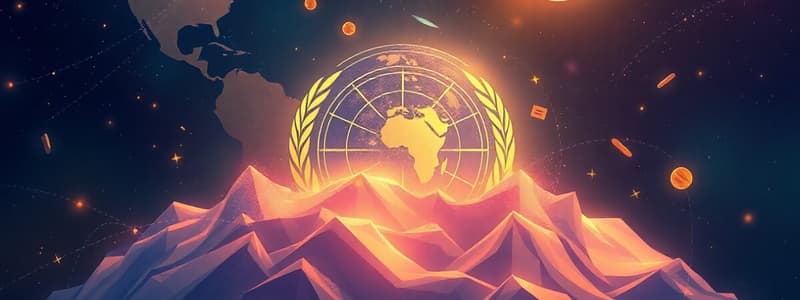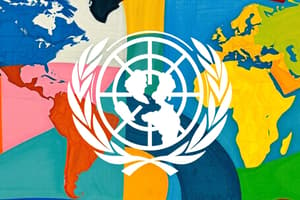Podcast
Questions and Answers
Which of the following best describes economic globalization?
Which of the following best describes economic globalization?
- The decrease in international cultural exchange
- The isolation of national economies to protect local industries
- The expansion of national economies into a global market with increased flows of goods and capital (correct)
- The convergence of political ideologies across nations
Economic integration only involves international consumer activity and exporting goods from one country to another.
Economic integration only involves international consumer activity and exporting goods from one country to another.
False (B)
Name three key actors that facilitate economic globalization, besides national governments.
Name three key actors that facilitate economic globalization, besides national governments.
International economic organizations, multinational companies, central banks
According to Wallerstein's world-system theory, the ________ is the center of economic activities.
According to Wallerstein's world-system theory, the ________ is the center of economic activities.
Match the following organizations with their roles in economic globalization.
Match the following organizations with their roles in economic globalization.
Which of the following is NOT a characteristic of the modern world system according to Wallerstein's theory?
Which of the following is NOT a characteristic of the modern world system according to Wallerstein's theory?
Economic globalization is a purely modern phenomenon, with no historical precedents.
Economic globalization is a purely modern phenomenon, with no historical precedents.
What is the primary role of International Financial Institutions (IFIs) in supporting a country's economic growth?
What is the primary role of International Financial Institutions (IFIs) in supporting a country's economic growth?
Global civil society consists of individuals or groups that are ________ by the effects of economic globalization, and protest and seek for alternatives.
Global civil society consists of individuals or groups that are ________ by the effects of economic globalization, and protest and seek for alternatives.
How do multinational corporations contribute to economic globalization?
How do multinational corporations contribute to economic globalization?
Flashcards
Economic globalization
Economic globalization
Expansion of national economies via technology and institutions, promoting faster flow of goods and capital.
Global economy
Global economy
National economies interconnected from extraction to disposal of goods and services.
International financial institutions
International financial institutions
Institutions supporting a country's economic growth through loans and technical assistance.
International Monetary Fund (IMF)
International Monetary Fund (IMF)
Signup and view all the flashcards
Global civil society
Global civil society
Signup and view all the flashcards
Global corporation
Global corporation
Signup and view all the flashcards
World system
World system
Signup and view all the flashcards
Economic integration
Economic integration
Signup and view all the flashcards
International economic organizations
International economic organizations
Signup and view all the flashcards
Multinational companies (MNCs)
Multinational companies (MNCs)
Signup and view all the flashcards
Study Notes
- Economic globalization, the expansion of national economies and the global market, is propelled by modern tech and institutional frameworks.
- These frameworks facilitate quicker and easier flow of products and capital.
Global Economy
- The global economy signifies the interconnectedness of various countries' economies.
- It spans from extraction and production to distribution, consumption, and disposal of goods and services.
International Financial Institutions
- These institutions support a country's economic growth through financial aid like loans and technical assistance.
- The aid is provided to governments and private sectors.
International Monetary Fund (IMF)
- The IMF is an organization consisting of 183 member countries.
- It promotes worldwide monetary cooperation and exchange rate stability.
- It also fosters economic growth and high employment.
- The IMF gives short-term financial assistance to countries to ease balance of payments adjustments.
Global Civil Society
- It consists of non-government institutions that operate across geographical borders.
- It organizes and mobilizes for a common issue or cause.
Global Corporation
- This is an enterprise involved in activities that add value—manufacturing, extraction, services, marketing—in more than one country.
World System theory
- This theory acknowledges that social and economic change isn't just internal to a country.
- It is affected by its interaction with external institutions.
- It focuses on world-systems.
Economic Integration
- This is a process of combining or increasing the interconnectivity of national economies.
- It extends to regional or global economies.
Economic Globalization
- Economic globalization involves the integration of functions and processes of economic activities.
- It requires creating institutions for market integration and globalization, going beyond just international consumer activity.
Drivers of Economic Globalization
- Economic globalization is driven by the growing scale of cross-border trade in commodities and services.
Global Economic Integration
- Global Economic Integration is significant to economic globalization.
- This means separate production operations are functionally related, forming a unified product or service.
- This necessitates skillful management of economic operations globally.
- Innovations in logistics, communication, transport, and supportive policies enable this.
- Neoliberal principles and market-driven activities govern this, with less governmental control
History of Economic Integration
- Global economic integration isn't new.
- Voyages by explorers in empires like the Roman Empire were crucial for intercontinental trade and precursors.
- Early trades in Asia also served as first forms of expansion and later integration.
- Globalization has been ongoing since Homo sapiens migrated from Africa.
- Earlier explorations focused on valuable commodities, and the difference now is the extent and the role of the private sector
Actors of Economic Globalization
- Globalization is not only driven by authority and actors.
- Non-state actors, such as international economic organizations, the private sector, central banks, and civil society helps drive economic globalization.
International Economic Organizations
- International economic organizations like the IMF, World Bank, and OECD are critical in pushing for neoliberal policies in countries.
Regional Organizations
- Regional organizations like ASEAN and NAFTA promote regional agreements to facilitate trade and exchange.
- They facilitate knowledge, human resources, and regional cooperation.
Advisory Organizations
- The Group of 8 (G8) and G20 discuss current economic and political problems.
- They transfer forum ideas into national legislative regulations.
Multinational Companies
- Multinational companies, numbering 44,000 in 1996 and 88,000 in 2006, are main drivers of economic globalization.
- Forerunners of modern MNCs were trade companies such as the Dutch and British East India companies.
- MNCs emerged during World War II due to increased US industrial production.
Central Banks
- Central banks are prime movers in the world economy, leading economic development.
- Some consider central bank governors more influential than politicians in national economies.
Global Civil Society
- Global civil society, made up of individuals affected by globalization, protests and seeks alternatives.
- They form a basis for a new world order, including Transnational Advocacy Networks that promote causes and policy changes.
Modern world system
- The modern world system is split into the core, semi-periphery, and periphery.
- The core is the center of economic activities with living populations, economic institutions, for services.
- The periphery has raw materials and productions.
- The semi-periphery distributes raw materials by processing them for the core.
Studying That Suits You
Use AI to generate personalized quizzes and flashcards to suit your learning preferences.




